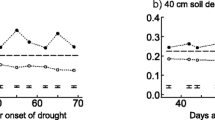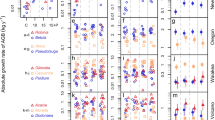Summary
We examined the effects of nitrogen nutrition and defoliation on the alkaloids, nitrogen levels, and growth of Lupinus succulentus by growing plants under five nitrogen/defoliation treatments: 1) fertilization with a high-nitrate nutrient solution, 2) fertilization with a low-nitrate solution, 3) inoculation with N-fixing bacteria but without available soil nitrogen, 4) high-nitrate solution plus periodic partial defoliation, and 5) low-nitrate plus defoliation. In the absence of defoliation, plants from both the N-fixing and high-N treatments had higher concentrations of alkaloids and nitrogen, and higher growth rates than the low-N plants. Periodic defoliation had little effect on the high-N plants, but defoliated N-fixing plants were severely stunted and had lower alkaloid and nitrogen levels. The experimental treatments also affected the relative concentrations of the alkaloids. Our results indicate that 1) alkaloid composition and concentration in L. succulentus are determined by both nitrogen availability and developmental state, 2) plants relying solely on N-fixation respond quite differently to defoliation than those with adequate soil nitrogen, and 3) the food value of the plant tissue can be affected by an interaction between the effects of defoliation and nitrogen status.
Similar content being viewed by others
References
Balandrin MF, Kinghorn AD (1981) Tetrahydrorhombifoline, a further constituent of Lupinus oscar-haughtii and L. truncatus. Journal of Natural Products 44:495–497
Belsky AJ (1986) Does herbivory benefit plants? A review of the evidence. Am Nat 127:870–892
del Moral R (1972) On the variability of chlorogenic acid concentration. Oecologia (Berlin) 9:289–300
Finke RL, Harper JE, Hageman RH (1982) Efficiency of nitrogen assimilation by N2-fixing and nitrate-grown soybean plants (Glycine max [L.] Merr.). Plant Physiol 70:1178–1184
Fishbeck KA, Phillips DA (1981) Combined nitrogen and vegetative regrowth of symbiotically-grown alfalfa. Agron J 73:975–978
Gordon WC, Henderson JHM (1951) The alkaloidal content of the blue lupine (Lupinus angustifolius) and its toxicity in small laboratory animals. J Agric Chem 41:141–145
Heller SR, Milne GWA (1980) EPA/NIH Mass Spectral Data Base, Supplement 1. National Bureau of Standards, Washington, DC
Johnson ND, Bentley BL (1988) The effects of dietary protein and lupine alkaloids on the growth and survivorship of Spodoptera eridania. J Chem Ecol (in press)
Kempthorne O (1975) Fixed and mixed models in the analysis of variance. Biometrics 31:473–486
Kinghorn AD, Selim MA, Smolenski SJ (1980) Alkaloid distribution in some new world Lupinus species. Phytochemistry 19:1705–1710
Layzell DB, Rainbird RM, Atkins CA, Pate JS (1979) Economy of photosynthate use in nitrogen-fixing legume nodules: observations on two contrasting symbioses. Plant Physiol 64:888–891
Lincoln DE (1985) Host-plant protein and phenolic resin: effects on larval growth and survival of a butterfly. J Chem Ecol 11:1459–1467
Lyttleton JW (1973) Proteins and nucleic acids. In: Butler GW, Bailey RW (eds) Chemistry and Biochemistry of Herbage, I. Academic Press, London, pp 63–103
Mattson WJ (1980) Herbivory in relation to plant nitrogen content. Ann Rev Ecol Syst 11:119–161
Mihaliak CA, Lincoln DE (1985) Growth pattern and carbon allocation to volatile leaf terpenes under nitrogen-limiting conditions in Heterotheca subaxillaris (Asteraceae). Oecologia (Berlin) 66:423–426
Munz PA (1968) A California Flora. University of California Press, Berkeley
Pate JS, Layzell DB, Atkins CA (1979) Economy of carbon and nitrogen in a nodulated and nonnodulated (NO3-grown) legume. Plant Physiol 64:1083–1088
Rosenthal GA, Janzen DH (1979) Herbivores: Their Interactions with Secondary Plant Metabolites. Academic Press, New York
Rosenthal GA, Hughes CG, Janzen DH (1982) L-canavanine, a dietary nitrogen source for the seed predator Caryedes brasiliensis (Bruchidae). Science 217:353–355
Schubert KR (1982) The Energetics of Biological Nitrogen Fixation. Am Soc Plant Physiol, Rockville, MD
Scriber JM, Slansky F (1981) The nutritional ecology of immature insects. Ann Rev Entomol 26:183–211
Slansky F, Feeny P (1977) Stabilization of the rate of nitrogen accumulation by larvae of the cabbage butterfly on wild and cultivated food plants. Ecol Monogr 47:209–228
Smolenski SJ, Kinghorn AD, Balandrin MF (1981) Toxic constituents of legume forage plants. Econ Bot 35:321–355
Sokal RR, Rohlf FJ (1981) Biometry. W.H. Freeman, San Francisco
Vance CP, Heichel GH, Barnes DK, Bryan JW, Johnson LE (1979) Nitrogen fixation, nodule development, and vegetative regrowth of alfalfa (Medicago sativa L.) following harvest. Plant Physiol 64:1–8
Waller GR, Nowacki EK (1978) Alkaloid Biology and Metabolism in Plants. Plenum Press, New York
Wink M (1984) Chemical defense of lupins. Mollusc-repellent properties of quinolizidine alkaloids. Z Naturforsch 39 C:553–558
Wink M, Hartmann T (1982) Diurnal fluctuations of quinolizidine alkaloid accumulation in legume plants and photomixotrophic cell suspension cultures. Z Naturforsch 37C:369–375
Wink M, Hartmann T, Witte L (1980a) Enzymatic synthesis of quinolizidine alkaloids in lupin chloroplasts. Z Naturforsch 35C:93–97
Wink M, Witte L, Schiebel HM, Hartmann T (1980b) Alkaloid pattern of cell suspension cultures and differentiated plants of Lupinus polyphyllus. Planta Medica 38:238–245
Wink M, Hartmann T, Witte L, Rheinheimer J (1982) Interrelationship between quinolizidine alkaloid producing legumes and infesting insects: exploitation of the alkaloid-containing phloem sap of Cytisus scoparius by the broom aphid Aphis cytisorum. Z Naturforsch 37C:1081–1086
Wink M, Witte L, Hartmann T, Theuring C, Volz V (1983) Accumulation of quinolizidine alkaloids in plants and cell suspension cultures: genera Lupinus, Cytisus, Baptisia, Genista, Laburnum, and Sophora. Planta Medica 48:253–257
Author information
Authors and Affiliations
Rights and permissions
About this article
Cite this article
Johnson, N.D., Liu, B. & Bentley, B.L. The effects of nitrogen fixation, soil nitrate, and defoliation on the growth, alkaloids, and nitrogen levels of Lupinus succulentus (Fabaceae). Oecologia 74, 425–431 (1987). https://doi.org/10.1007/BF00378940
Received:
Issue Date:
DOI: https://doi.org/10.1007/BF00378940




